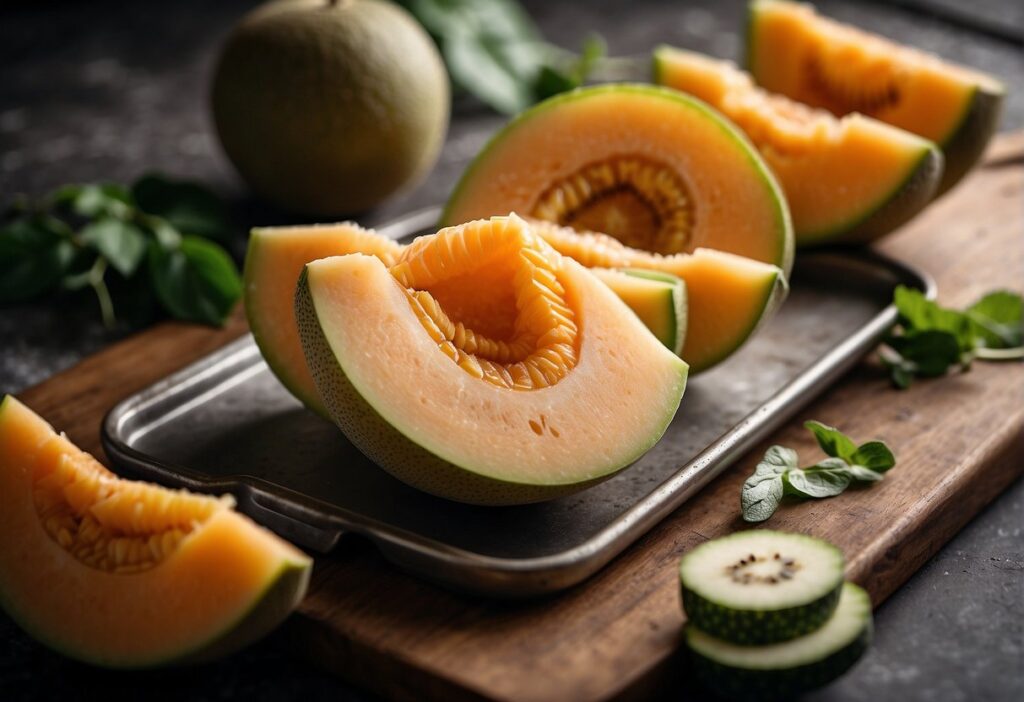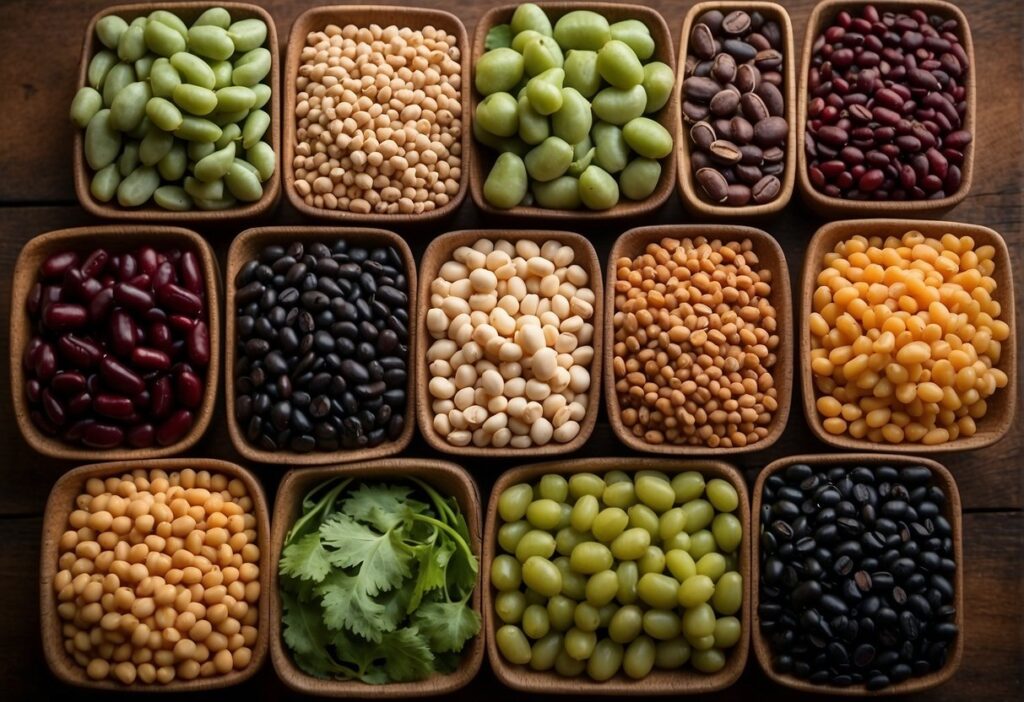
Freezing cantaloupe is a topic that often arises during peak melon season when ripe, fresh cantaloupes are abundantly available. The desire to preserve the sweet taste of summer leads many to wonder whether it is possible to freeze this fruit effectively. Indeed, cantaloupe can be frozen, allowing you to enjoy its flavor long after its season has passed. The process is straightforward, but certain steps must be taken to ensure the fruit retains as much of its original texture and flavor as possible.
Preparing cantaloupe for freezing is a crucial step. The fruit must be ripe, but not overripe, to achieve the best results. A ripe cantaloupe will have a sweet aroma at the blossom end and a rind that’s slightly soft to the touch. It’s best to wash the outer surface, cut the fruit into manageable pieces, remove all seeds and rind, and then cut these pieces into the desired sizes. Freezing fresh cantaloupe in this way ensures that the fruit is convenient to use after thawing.
Key Takeaways
- Freezing cantaloupe preserves its sweet summer flavor for later use.
- Properly preparing the fruit before freezing enhances retention of texture and taste.
- Stored correctly, frozen cantaloupe can be a versatile addition to various dishes.
Preparing Cantaloupe for Freezing

Freezing cantaloupe requires proper preparation to maintain freshness and flavor. When done correctly, it allows the fruit to be enjoyed out of season.
Selecting the Right Fruit
The first step is to choose ripe cantaloupes, which are essential for the best flavor after freezing. A ripe cantaloupe has a firm, netted skin without any soft spots and a sweet fragrance at the blossom end. Look for fruit that is heavy for its size, indicating a good moisture content, which is preferable for freezing.
Washing and Cutting
Begin by washing the cantaloupe thoroughly with water to remove any dirt or bacteria from the skin. After drying, place the cantaloupe on a stable cutting board and use a sharp knife to cut the fruit in half. Remove the seeds and scoop out the flesh. Then, proceed to cut the cantaloupe into uniform chunks or slices, easing the packing and thawing process.
Sugar Syrup Preparation
To prepare a sugar syrup that will help preserve the color and texture of the cantaloupe, dissolve granulated sugar in water by heating it gently. For every cup of water, use approximately one cup of sugar. Allow the mixture to cool completely before use. Alternatively, honey or lime juice can be added to make a simple syrup, offering a variety of flavors. Once cooled, pour the syrup over the prepared cantaloupe chunks to prevent them from drying out in the freezer.
Freezing Process
When preparing cantaloupe for freezing, it is crucial to select the appropriate containers, and to implement freezing methods that will ensure the fruit’s flavor and texture are preserved as best as possible.
Storage Containers
Choosing the right storage containers is essential for maintaining the quality of frozen cantaloupe. Airtight containers or freezer containers with a tight-fitting lid are recommended to prevent freezer burn and flavor loss. For convenience, you can also use freezer bags after removing as much air as possible, potentially with the aid of a vacuum sealer. Additionally, if freezing cantaloupe puree, an ice cube tray can be covered and utilized before transferring the frozen cubes into freezer bags for long-term storage.
- Recommended containers:
- Airtight containers with a secure lid
- Freezer bags (with air removed)
- Ice cube trays (for puree)
Freezing Methods
Cantaloupe can be frozen in chunks or as a puree. To freeze cantaloupe chunks, first, clean the fruit thoroughly then cut it into uniform pieces. These pieces should be spread out on a baking sheet and placed in the freezer to flash freeze. Once frozen, the cantaloupe chunks can be transferred to the chosen airtight freezer containers.
- Steps for freezing cantaloupe chunks:
- Clean and cut cantaloupe into uniform chunks.
- Spread chunks on a baking sheet to flash freeze.
- Transfer frozen chunks into airtight containers or bags.
For freezing pureed cantaloupe, blend the fresh cantaloupe until smooth, pour the puree into an ice cube tray or airtight container, and freeze. Once solidified, the cubes of puree can be moved into a freezer-safe container or bag for extended storage.
- Instructions for freezing pureed cantaloupe:
- Blend cantaloupe into a smooth puree.
- Pour puree into an ice cube tray or container to freeze.
- Once frozen, store the puree cubes in freezer containers or bags.
Using Frozen Cantaloupe
Before using frozen cantaloupe, understanding the appropriate methods for thawing is essential, as well as recognizing the diverse culinary applications for which it is well-suited.
Thawing and Defrosting
To thaw frozen cantaloupe, place it in the refrigerator for a few hours or overnight, ensuring it retains most of its texture. For a quicker method, defrost cantaloupe by submerging the sealed bag in cold water. Avoid microwaving, as it can result in a mushy texture.
Culinary Uses
Frozen cantaloupe is versatile in the kitchen. Below are two main ways to incorporate it into dishes:
- Smoothie: Blend frozen cantaloupe to create a refreshing smoothie, adding texture and a cold element without the need for ice.
- Desserts: Use it in various desserts such as fruit salad, cantaloupe sorbet, or even homemade cantaloupe ice cream. Frozen pieces provide a nice chill and concentrated flavor.
Here’s a simple table outlining uses for frozen cantaloupe:
| Use Case | Preparation | Notes |
|---|---|---|
| Smoothie | Blend with other fruits, yogurt or juice | No need to thaw; use directly from the freezer |
| Fruit Salad | Thaw and mix with fresh fruits | Enhances coldness and flavor concentration |
| Sorbet | Puree, add sweetener, and freeze | A smooth, cold dessert perfect for warm days |
| Ice Cream | Blend with cream and sugar, then churn | A unique homemade dessert choice |
When using frozen cantaloupe, these methods allow cooks to utilize the fruit’s full potential, offering a variety of ways to enjoy its sweet flavor.
Storing and Preservation Tips
When preserving cantaloupe, understanding its shelf life and safety considerations is crucial to maintaining its quality and preventing spoilage.
Shelf Life and Quality
Cantaloupe’s shelf life depends on ripeness at the time of purchase. A whole, ripe cantaloupe can last up to 5 days on the counter and about 10 days in the refrigerator. To extend this period, freezing is an option, but one should anticipate a change in texture and firmness; cantaloupes become softer once thawed. When frozen properly, cantaloupe can maintain a good flavor and color for up to three months.
Freezing Tips:
- Cut the fruit into bite-sized pieces or puree it.
- Place on a tray to freeze individually, then transfer to a sealed bag or container.
- Label with the date to keep track of how long it’s been stored.
Safety Considerations
When preserving cantaloupe, safety is paramount. Improper storage can introduce or proliferate harmful bacteria like salmonella, leading to foodborne illnesses. Before freezing, ensure the fruit is clean and dry to prevent bacterial growth and mold formation.
Monitoring Signs of Spoilage:
- Check for changes in appearance or development of mold.
- Smell the cantaloupe for an off odor, which indicates spoilage.
- Discard any fruit that exhibits signs that it has begun to spoil.
By following these tips, cantaloupes can be stored safely while maintaining their best qualities.




